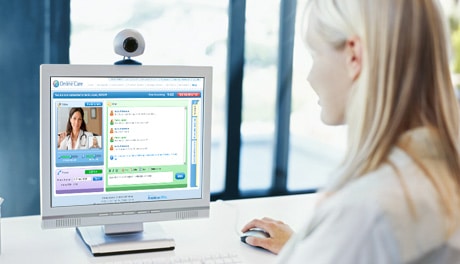Intermountain Healthcare: Optimizing the Patient Experience Through Telehealth Interoperability
Intermountain Healthcare, a not-for-profit integrated health system headquartered in Utah, has built a robust virtual health program that includes Connect Care, its direct-to-consumer telehealth service and Connect Care Pro, its acute care program. As a healthcare innovator, Intermountain has worked diligently to put in place both patient-facing and back-end integrations needed for successful enterprise-wide telehealth interoperability.
In this two-part interview, leaders from Intermountain’s digital team discuss Connect Care’s telehealth integration and interoperability from the perspective of the patient and from that of the provider. Today’s interview focuses on telehealth integration and interoperability from the perspective of the patient—from Intermountain’s innovative Digital Front Door initiative to its broader vision of how telehealth fits into that consumer digital experience. Today we’ll be hearing from Tim Lovell, Director of Operations for Intermountain Connect Care, Bryan Wang, Connect Care Product Manager, and Jared Antczak, Director, Consumer Digital Solutions.

Intermountain is in the process of optimizing the patient telehealth experience. Can you tell us about Intermountain’s approach to consumer telehealth?
Jared Antczak: When we think about our patient experience, we recognize telehealth is critical to that strategy. Intermountain has actively been working on an initiative called the Digital Front Door (DFD). When we embarked on developing this initiative, it was critical to have support, guidance, and advocacy from our leadership. Our CEO Marc Harrison joined Intermountain in 2016 and he added the new executive role of chief consumer officer, which was filled by Kevan Mabbutt, who came from the Walt Disney Company.
We benefitted from having expertise from outside the traditional healthcare industry as we thought about how we wanted to provide an extraordinary consumer experience. We started with the ideal state in mind, meaning what would the perfect experience look like regardless of resource constraints, technical limitations, and costs? Then we worked backward to develop what we considered the minimum viable product (MVP).
Can you walk through what the consumer experience looked like before the DFD initiative, and what it will look like within the MVP?
Jared Antczak: Intermountain started with a fairly sophisticated digital presence for our patients and consumers. We had mobile apps and websites, and they all provided a robust set of features and functionalities. The problem was that they were all developed independently of each other—many required different logins and all of them had a different user experience and design construct. What we did with the DFD was tie all these assets, features, and functionalities together into an intuitive and seamless digital experience that allows the consumer to navigate through their care journey much more easily than before.
We engaged consumers directly through usability testing, consumer surveys, and interviews to really understand what it could and should look like. What we ultimately ended up with was a new platform that uses one set of credentials to authenticate. It’s not just a collection of features; it’s a consumer journey where one action naturally flows into the next. For example, if you wanted to engage with a telehealth visit, you could do so with the same set of credentials you use to see your past clinic notes and lab results, or to pay your bill. All of that is tied neatly together on the back end, and from the end-user standpoint it feels like a single user experience and application.
How are you rolling this initiative out?
Jared Antczak: It was quite an undertaking, so we broke the work up into several phases that matched different aspects of the consumer journey, from finding care to managing care to paying for care. At our peak, we had over 150 full-time employees working on the product, with another 100 part-time cross-functional stakeholders from across the organization engaged in the initiative. We’ve developed and deployed our MVP into four pilot clinics with roughly 1,500 patient users. We are now preparing for a broad launch across our enterprise.
How involved has the telehealth team at Intermountain been in the DFD initiative?
Jared Antczak: The telehealth team has been critically involved to ensure the integration of our telehealth product into the DFD is seamless, performant and functional within this new platform. The goal is for this to be as good as, if not better than, the standalone telehealth application that previously existed.
Can you talk about the Digital Front Door initiative from a technology integration perspective?
Bryan Wang: We focused on how to integrate the consumer telehealth experience for Amwell into our unified DFD patient front-end experience. For the front end, we leveraged Amwell’s software development kit (SDK) to fully integrate all patient interactions into the DFD within both web and mobile. It’s important to understand that the experience is not simply a web view of the white label application; it’s fully customized and consistent with the rest of the DFD workflow. We worked closely and extensively with Amwell’s SDK team to make this a reality.
On the back end there are two parts to the integration. First, how do we communicate intake and video feedback information back and forth between the DFD app and Amwell servers. This is generally taken care of by the SDK. Secondly, with the DFD we are introducing an additional identity source. In order to resolve the differences between DFD, Amwell, and Cerner and make sure these three sources are synced, we leverage some cutting-edge interoperability principles. For example, we leverage a lot of FHIR APIs to pull information from Cerner and communicate that with DFD. Then between DFD and Amwell, we leverage Amwell’s patient identity API. The final lever is Amwell back to Cerner, which uses our existing integration of the HL7 interface.
If you could share some top best practices with other health systems looking at these types of integrations, what would they be?
Tim Lovell: It’s important to design around the end-user experience. For the patient, ask yourself how this will affect their access to care, and for the provider how will it improve their efficiency? You also want to involve the right teams early on. The level of commitment required to coordinate this is not simple. The multiple layers of connectivity and integration need to be considered and thought through. Lastly, pivoting around roadblocks is critical and it’s a huge change effort. We encourage a lot of flexibility among team members thinking about things in different ways.
Check back next week for part two of the interview discussing Intermountain’s EMR telehealth integrations to improve the provider experience.


